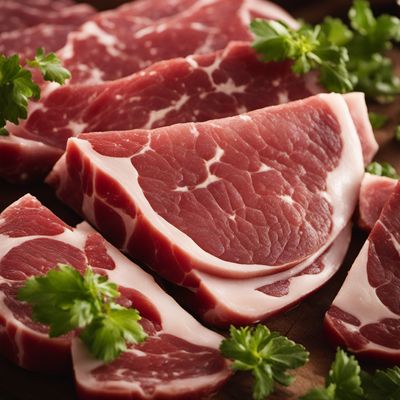
Ingredient
Buffalo, american fresh meat
The Mighty Bison
Buffalo meat is characterized by its deep, earthy flavor and tender texture. It is leaner than beef, yet still succulent and juicy. The meat ranges in color from deep red to dark brown and has a slightly sweet and nutty undertone. Its marbling is minimal, resulting in a leaner cut that is both healthy and delicious.
Origins and history
Buffalo has a long-standing history in Native American culture, where it was revered as a sacred animal and a vital source of sustenance. Native tribes hunted buffalo for their meat, hides, and bones, utilizing every part of the animal. Today, buffalo is still an important part of Native American cuisine and is also enjoyed by many as a healthier alternative to beef.
Nutritional information
Buffalo meat is a nutrient-dense protein source, rich in essential amino acids, iron, and vitamin B12. It is lower in fat and calories compared to beef, making it a healthier choice for those looking to reduce their intake of saturated fats.
Allergens
Buffalo meat is free from common allergens such as gluten, dairy, and soy. However, individuals with meat allergies should exercise caution and consult with a healthcare professional if unsure.
How to select
When selecting buffalo meat, look for cuts that are deep red in color, with minimal browning or discoloration. The meat should be firm to the touch and have a fresh, slightly sweet aroma. Avoid any cuts that appear slimy or have a strong odor, as these may indicate spoilage.
Storage recommendations
To maintain the freshness and quality of buffalo meat, store it in the refrigerator at a temperature below 40°F (4°C). Keep the meat in its original packaging or wrap it tightly in plastic wrap or aluminum foil to prevent air exposure. Use within 2-3 days of purchase or freeze for longer storage.
How to produce
Buffalo can be raised on specialized farms or ranches that focus on sustainable and ethical practices. However, due to their size and specific dietary needs, raising buffalo requires ample space and resources. It is best left to experienced farmers or ranchers.
Preparation tips
Buffalo meat can be prepared in various ways, including grilling, roasting, or braising. It pairs well with bold flavors and spices, such as garlic, rosemary, and cayenne pepper. For optimal tenderness, marinate the meat before cooking and cook it to medium-rare or medium doneness. Sliced buffalo meat is also commonly used in stir-fries, stews, and chili.
Substitutions
Beef can be used as a substitute for buffalo meat, as they share similar flavor profiles and cooking methods. However, keep in mind that beef has a higher fat content compared to buffalo, so adjust cooking times and temperatures accordingly.
Culinary uses
Buffalo meat is commonly used in dishes such as burgers, steaks, meatballs, and chili. It is also a popular choice for jerky and sausages. In Native American cuisine, buffalo is often prepared in traditional dishes like pemmican, a mixture of dried meat, fat, and berries.
Availability
Buffalo meat is primarily available in North America, particularly in the United States and Canada. It can be found in specialty butcher shops, farmers markets, and some supermarkets. It is also available online for nationwide delivery.
More ingredients from this category

Buffalo fresh meat
The Lean and Flavorful Protein

Buffalo, african fresh meat
The African Delicacy: Fresh Buffalo Meat

Yak fresh meat
The Exquisite Delicacy of Yak Meat

Calf fresh meat
Tender Delight: Exploring the World of Calf Fresh Meat

Zebu fresh meat
The Exotic Delicacy

Cow, ox or bull fresh meat
The Prized Protein: Exploring Cow, Ox, or Bull Fresh Meat

Bovine, minced meat
Versatile Ground Beef